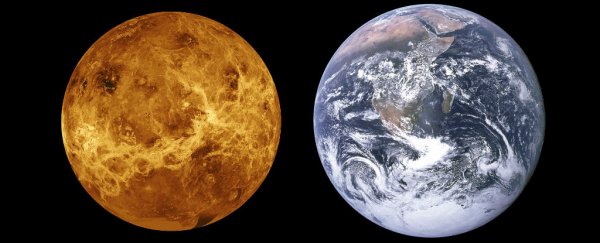With its acid thunderclouds, scorching surface, and atmospheric pressure that would crush your bones, the oppressive hellscape of Venus makes it one of the most uninviting places in the entire Solar System.
But it's looking more and more likely that when life first evolved on Earth, Venus might have actually been a viable holiday destination.
"Both planets probably enjoyed warm liquid water oceans in contact with rock and with organic molecules undergoing chemical evolution in those oceans," David Grinspoon at the Planetary Science Institute in Tucson, Arizona told Aviva Rutkin at New Scientist.
"As far as we understand at present, those are the requirements for the origin of life."
Scientists have been proposing for years now that Venus might not have always been the hottest planet in the Solar System.
Back in 2010, researchers have pointed to the fact that Earth and Venus are surprisingly similar in size, density, and composition, their close proximity suggesting that they were probably formed using the same base materials.
"Venus also has an unusually high ratio of deuterium to hydrogen atoms, a sign that it once housed a substantial amount of water, mysteriously lost over time," says Rutkin.
Now, the case for Venus's more friendly past just got even stronger, with new climate models showing that up to 3 billion years ago, Venus could have had mild, Earth-like temperatures and liquid oceans.
The team, led by Michael Way from the NASA Goddard Institute for Space Studies, simulated four versions of early Venus, tweaking each one slightly by certain factors such as the length of a day and the amount of energy it received from the Sun.
As the four models evolved over billions of years, the most promising one not only boasted moderate temperatures, dense cloud cover that would have protected the surface from the Sun's harsh radiation, and sometimes even snow, it would have remained habitable until just 715 million years ago.
But there's one big caveat: for this model to produce habitable conditions for a 2-billion-year stretch, Venus had to have been spinning as slowly as it is today - something that researchers are yet to prove. And since Earth's rotation has been steadily slowing down, some researchers have argued that Venus did in fact spin faster in the past.
"If Venus was spinning more rapidly, all bets are off," one of the team, Michael Way, from the NASA Goddard Institute for Space Studies, told Maddie Stone at Gizmodo. But, under the right conditions, "You get temperatures almost like Earth. That's remarkable."
Now, I don't want to get all "aliens!" up in here, but a couple of billion years is an awful long time to be habitable, so if these models are accurate, there's a chance that life could have evolved on Venus at that time, just like it did on Earth.
Unfortunately, the Venus of today isn't exactly the easiest place to search for clues of long-lost life.
As Nola Taylor Redd over at Space.com explains, Venus is the hottest planet in the Solar System, and it's covered in clouds made from sulphuric acid that spew forth the strangest lightning ever detected.
If you were to stand on the surface of Venus, you'd experience air about 90 times heavier than Earth's atmosphere, and pressures similar to diving 3,000 feet (914 metres) beneath the ocean.
So how did Venus go from being Earth's habitable twin to being Earth's evil twin?
"It's one of the big mysteries about Venus. How did it get so different from Earth when it seems likely to have started so similarly?" Grinspoon told New Scientist. "The question becomes richer when you consider astrobiology, the possibility that Venus and Earth were very similar during the time of the origin of life on Earth."
The team says the only way we're going to get to the bottom of if Venus was once habitable, how it got so hellish, and if life did actually have a chance to evolve there, is to actually go there - something that NASA is already considering.
Seriously, let's do it.
The study has been accepted for publication in Geophysical Research Letters.
